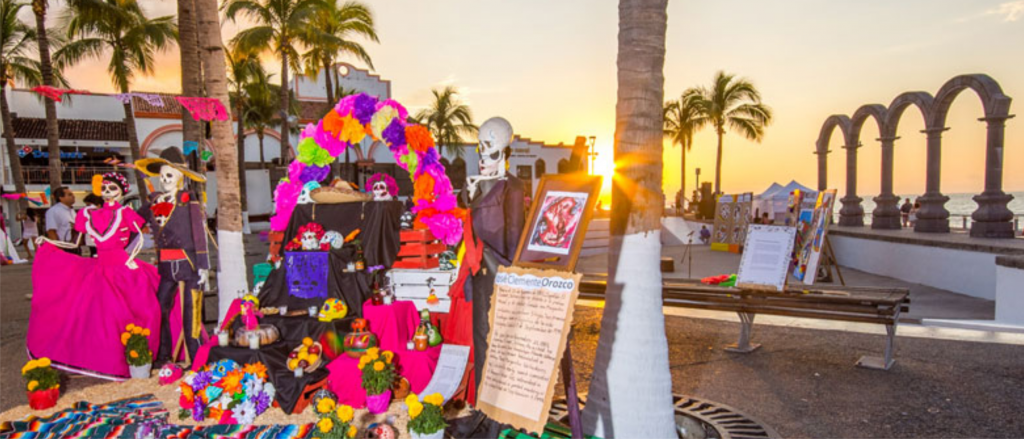Hello travelers, today we’ll talk about one of the most emblematic celebrations of Mexican culture, the Day of the Dead. A festival missing from most other countries and cultures of the world, Dia de Los Muertos, is celebrated with color, marigold flowers, food, and paper decorations.
In Puerto Vallarta, you can find many altars along the Malecón, paying tribute in creative and respectful ways to our country’s famous people and local heroes. You can also find representations of “La Catrina,” an expression of death dressed as an elegant woman.

To understand the celebration, it’s necessary to go back to its origins. The Day of the Dead dates back to before the arrival of the Spanish to the American continent. In that period, many Mesoamerican ethnic groups worshiped death. Among them was the Mexica, also known as Aztecs. The Aztec people had gods in charge of defining the destiny of human souls; these gods were Mictecacíhuatl and Mictlantecuhtli. Both were lords of Mictlán or “place of the dead.” However, to get there, the souls had to go through a series of obstacles to get eternal rest.
The Mictlán was divided according to the manner of dying. For example, the warriors who died in battle entered the Tonatiuh Ichan, the house of the sun. Those who died as infants went to the Cincalco, the home of the god Tonacatecutli known for innocence.
Then entered the Day of the Dead offerings, which are altars of pre-Hispanic origin. These were dedicated to different deities and were placed on different dates. The lord of the dead, Mictlantecuhtli, was celebrated in the month that we now know as November. The evangelists used this coincidence during the colonized period to make a syncretism between Christianity and indigenous religious beliefs.
Initially, the altars were placed on October 30 or 31, and they remained until the 3rd of November. It’s common to display the altars several days earlier due to the creative effort invested in placing them. However, November 1st and 2nd have not ceased to be the main days of celebration. On these two dates, all the souls that have shed their bodies, that is, our deceased, visit us.
Furthermore, altars must have specific components, and each of these has a special meaning.
Photograph of the deceased: An image honors the highest part of the altar. It’s placed on the back, and in the front, a mirror is positioned so the deceased can see their relatives’ reflection.
Copal and incense: Copal is a pre-Hispanic element that cleanses and purifies the energies of a place and those who use it; incense sanctifies the environment.
Paper decoration: It is considered a representation of the Day of the Dead’s festive joy and the wind.
Candles: All these elements are considered as a guiding light in this world. They are, by tradition, purple and white, as they signify mourning and purity, respectively. The tapers can be placed according to the cardinal points and extend as a path to reach the altar.
Water: Reflects the purity of the soul, the endless sky, and the regeneration of life and crops. A glass of water is used for the spirit to quench its thirst after the journey from the world of the dead.
Food and drink: Traditional foods or those that were liked by the deceased are placed on the altar for the visited soul to enjoy.
White tablecloth and salt: They signify purity and joy. The salt serves so that the body of the deceased is not corrupted on the round trip.
Ash cross: The ash cross serves so that the soul reaches the altar and can atone for its pending sins. If the anima is in purgatory, the cross can help it out.
As you can see, the Day of the Dead is a special day within Mexican culture. A pre-Hispanic tradition that endures in the hearts of many who pay tribute to their friends and family members who have passed away.

